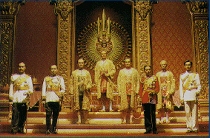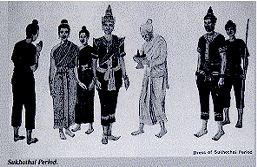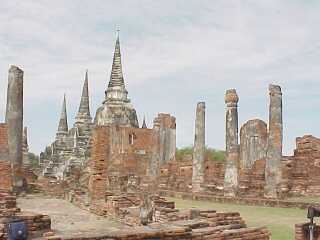









Introduction to Thailand Thailand, formerly called "Siam", is a country rich in culture and natural beauty. It has been blessed with expansive natural parks, fertile plains, remote jungles, beaches washed by turquoise waters, and tropical islands bathed in endless sunshine. The country has more visible historical evidence of its past cultures than any other country in Southeast Asia. Its history is very complex, involving the invasion of many different peoples, the rule of different kings, the establishment of various kingdoms and the interaction of diverse cultures. The period of time from the mid 1800's until now is probably the most important in terms of the formation of modern day Thailand. King Mongkut, who ruled the country from 1851 to 1868, was a well educated, ex-monk who kept Thailand safe from European expansion. His son, Chulalongkorn, took over in 1868 and continued the enlightenment and modernization of Thailand. King Chulalongkorn made great strides in improving the country, however he refused to allow his people democratic rights. This finally led to a takeover by Thai intellectuals, along with military help, in 1932. The name of the country was changed from Siam to Thailand in 1939 by Prime Minister Phibun Songkhram, mainly because he wanted to disassociate his country from its erratic past. Translated literally, Thailand means "Free Land". The Thai race was previously believed to have originated somewhere near Mongolia, later moving southward. However, new theories based on historical discoveries regard the northeastern part of Thailand as the birthplace of the Thai race. Over the years, the country has become home to many immigrants. The Thai people have managed to preserve the traditions of their unique culture, at the same time absorbing the practices of modern living. Nevertheless, the combination of cultures and backgrounds of these immigrants make Thailand an interesting and memorable country to visit. History Thailand means "land of the free", and throughout its 800-year history, Thailand can boast the distinction of being the only country in Southeast Asia never to have been colonized. Its history is divided into five major periods : Nanchao Period (650-1250 A.D.) The Thai people founded their kingdom in the southern part of China, which is Yunnan, Kwangsi and Canton today. A great number of people migrated south as far as the Chao Phraya Basin and settled down over the Central Plain under the sovereignty of the Khmer Empire, whose culture they probably accepted. The Thai people founded their independent state of Sukhothai around 1238 A.D., which marks the beginning of the Sukhothai Period. |
Sukhothai Period (1238-1378 A.D.) Thais began to emerge as a dominant force in the region in the13th century, gradually asserting independence from existing Khmer and Mon kingdoms. Called by its rulers "the dawn of happiness", this is often considered the golden era of Thai history, an ideal Thai state in a land of plenty governed by paternal and benevolent kings, the most famous of whom was King Ramkamhaeng the Great. However in 1350, the mightier state of Ayutthaya exerted its influence over Sukhothai. |
Ayutthaya Period (1350-1767) The Ayutthaya kings adopted Khmer cultural influences from the very beginning. No longer the paternal and accessible rulers that the kings of Sukhothai had been, Ayutthaya's sovereigns were absolute monarchs and assumed the title devaraja (god-king). The early part of this period saw Ayutthaya extend its sovereignty over neighboring Thai principalities and come into conflict with its neighbours, During the 17th century, Siam started diplomatic and commercial relations with western countries. In 1767, a Burmese invasion succeeded in capturing Ayutthaya. Despite their overwhelming victory, the Burmese did not retain control of Siam for long. A young general named Phya Taksin and his followers broke through the Burmese encirclement and escaped to Chantaburi. Seven months after the fall of Ayutthaya, he and his forces sailed back to the capital and expelled the Burmese occupation garrison. |
Thon Buri Period (1767-1772) General Taksin, as he is popularly known, decided to transfer the capital from Ayutthaya to a site nearer to the sea which would facilitate foreign trade, ensure the procurement of arms, and make defence and withdrawal easier in case of a renewed Burmese attack. He established his new capital at Thon Buri on the west bank of the Chao Phraya River. The rule of Taksin was not an easy one. The lack of central authority since the fall of Ayutthaya led to the rapid disintegration of the kingdom, and Taksin's reign was spent reuniting the provinces |
Rattanakosin Period (1782 - the Present) After Taksin's death, General Chakri became the first king of the Chakri Dynasty, Rama I, ruling from 1782 to 1809. His first action as king was to transfer the royal capital across the river from Thon Buri to Bangkok and build the Grand Palace. Rama II (1809-1824) continued the restoration begun by his predecessor. King Nang Klao, Rama III (1824-1851) reopened relations with Western nations and developed trade with China. King Mongkut, Rama IV, (1851-1868) of "The King and I" concluded treaties with European countries, avoided colonialisation and established modern Thailand. He made many social and economic reforms during his reign . King Chulalongkorn, Rama V (1869-1910) continued his father's tradition of reform, abolishing slavery and improving the public welfare |
and administrative system. Compulsory education and other educational reforms were introduced by King Vajiravudh, Rama VI (1910-1925). During the reign of King Prajadhipok, (1925-1935), Thailand changed from an absolute monarchy to a constitutional monarchy. The king abdicated in 1933 and was succeeded by his nephew, King Ananda Mahidol (1935-1946). The country's name was changed from Siam to Thailand with the advent of a democratic government in 1939. Our present monarch, King Bhumibol Adulyadej, is King Rama IX of the Chakri Dynasty. |
General Information Geography : The Kingdom of Thailand, covering an area of 514,000 square kilometres, lies in the heart of Southeast Asia, roughly equidistant between India and China. It shares borders with Myanmar to the west and north, Lao P.D.R. to the north and northeast, Cambodia to the east and Malaysia to the south. Topography : Thailand is divided into four distinct areas : the mountainous North, the fertile Central Plains, the semi-arid plateau of the Northeast, and the peninsula South, distinguished by its many beautiful tropical beaches and offshore islands. Climate : Thailand has a humid, tropical climate, and is hot all year round. Summer is from March to May with average temperatures around 93 F (34 C), but the temperature can reach over 105 F (40 C) for extended periods. Summer monsoons begin as the warm humid air masses flow towards the north from the Indian Ocean. The monsoons end in the fall when the wind reverses direction with the dry southwesterlies. The rainy season, with periods of sunshine, lasts from June to September, with temperatures ranging from 80F to 89 F (27 C to 32 C). The amount of rainfall varies with topography. The northeast receives the least rain, while the south is flooded during the summer months. The best time to visit Thailand is during the cool season, from October though February, when it is not as humid as during the summer and rainy seasons. The average temperature is around 65 F to 89 F (18 C to 32 C). During this season, it can be very chilly in the north, with temperatures dropping to 44 F (7 C) at night. Population : Thailand has a population of about 60 million. Ethnic Thais form the majority, though the area has historically been a migratory crossroads, and thus strains of Mon, Khmer, Burmese, Lao, Malay, Indian and most strongly, Chinese stock produce a degree of ethnic diversity. Integration is such, however, that culturally and socially there is enormous unity. |
Religion : Thailand is one of the most strongly Buddhist countries in the world. The national religion is Theravada Buddhism, a branch of Hinayana Buddhism, practiced by more than 9% of all Thais. The remainder of the population adheres to lslam, Christianity, Hinduism and other faiths - all of which are allowed full freedom of expression. Buddhism continues to cast strong influence on daily life. Senior monks are highly revered. Thus, in towns and villages, the temple (wat) is the heart of social and religious life. Meditation, one of the most popular aspects of Buddhism, is practiced regularly by numerous Thai as a means of promoting inner peace and happiness. Visitors, too, can learn the fundamentals of this practice at several centers in Bangkok and elsewhere in the country. |
People and Culture : Over the years, Thailand has attracted many immigrants. The people of Thailand share a rich ethnic diversity consisting of Thai, Mon, Khmer, Laotian, Chinese, Malay, Persian and Indian descendants. As a result, it is not possible to speak of a typical Thai physique. The Thais are, on the whole, a group of people who believe that life should be enjoyed, but no one should infringe on others' rights. The Thais are tolerant and hospitable, and it is easy to get along with them. Good manners, common sense and a smile are necessities in Thailand. Women have considerable influence in Thai society. Although the men's role is usually accentuated in public, in private, all affairs such as finances and other transactions are generally managed by women. Monarchy and religion are sacred in Thailand, and it is against the law to criticize them, especially in public. Mocking the monarchy, or joking about it, is a serious offense and is punishable by imprisonment. |
Acentric Company Limited 55/710 Moo 2, Sakdidet Road, Tambon Vichit, Phuket 83000 Thailand Tel: +66 76 286-381-5 | Fax: +66 76 286-382/+66 76 396-177 Email: info@thailandlodgings.com Web: www.thailandlodgings.com |
[ Bangkok Hotels ] [ Hua Hin Hotels ] [ Khao Lak Hotels ] [ Krabi Hotels ] [ Phi Phi Island Hotels ] [ Phuket Hotels ] |
